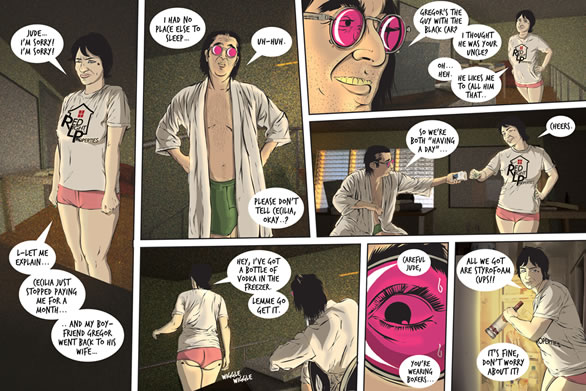There’s a real marriage of magic and the mundane in RLP – A feeling that magic is *real* because of the matter-of-fact way that people deal with it, as opposed to the more sensational “Oh my god, what was that?” of other supernatural/magical realist stories. In a way, it reminds me of Jonathan Carroll – Where did that come from? What are your influences in the worldbuilding of Red Light Properties?
It’s really a matter of telling the story from characters’ perspectives, where the spirit world is real and something they unfortunately have to co-exist with; the angle they see Miami (and the world) from is different… and when their reality brushes up against “ours”, that where the meat of a story lies. That’s something we’re going to be seeing a lot more of as the series goes forward: how something fantastical that they take for granted reconciles itself with a science-based framework… or even worse, a political one. Or worse than that, a religious one.
I’m a big admirer of Jonathan Carroll’s style, but there are certainly heavier influences running the gamut from Philip Roth to Terence McKenna, Brendan McCarthy, Larry David, Vince Gilligan… but the biggest influence has to be the city of Miami, where I grew up. There’s a particular vibe there, some kind of sun-bleached darkness is the best way I can describe it, that always fascinated me, had me peeking into dark corners and buying historical books on the city’s foundation. It’s all going to start pouring out of these panels eventually.

The art is very individual, mixing photography and lineart – Why’d you choose to mix the two (The photographic backgrounds really make the more psychadelic sequences pop, by comparison)? What’s the process for putting the pages together?
The digital-collage/comic art style I’m using with this series a continuation of my work from my 2007 graphic novel Shooting War and my webcomic Kelly before that… but for this series, I’ve added in the use of 3D models as well. Using a architectural rendering engine, I’m able to design virtual sets and change the lighting according to the time of day. I’m constantly frustrated by my art, and thus looking for new ways to do what I do better and with less hair-pulling and crying.
My work is created entirely digitally, drawn with electronic pens on touchscreens. I use both a Wacom Cintiq and an Axiotron Modbook; they’re both invaluable tools… I couldn’t do those eight page chapters without them.
I always begin with full-script; that’s the place the ideas are committed, and I get really formal and anal even though I’m writing just for myself at the moment. From there, all my chicken-scratch layouts are done in Sketchbook Pro, and from there I shoot actors for anatomy and position and performance until I’m satified that I’m capturing the tone of what I’ve put down in my script. I manage all my character reference photography in Adobe Lightroom, drawn all my line art in Adobe Illustrator, model/render background environments in Maya.
Once all the elements are created, everything is composited into a Photoshop PSD, where I color, assemble, re-light, letter and export the final comic panels for use in print or online. If I’m compiling a book, I’ll create printer-ready files in InDesign.

